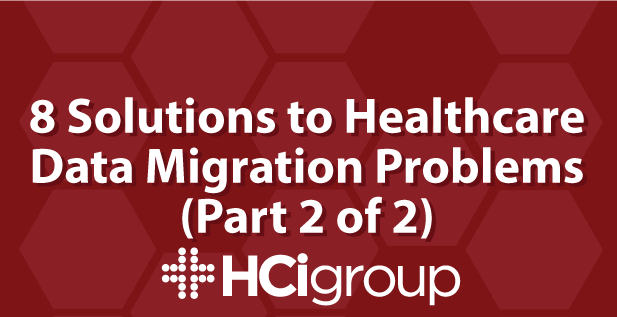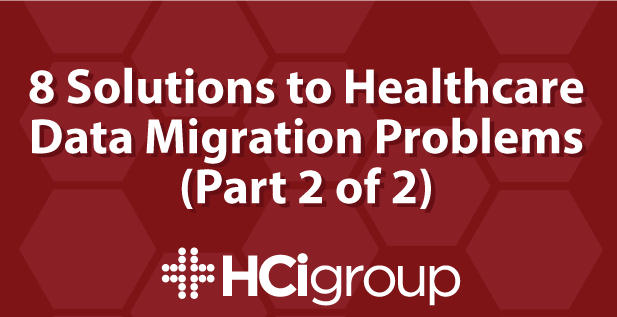8 Solutions to Healthcare Data Migration Problems (Part 2)


If you missed the first part of this series, you can catch up by clicking here.
Care providers need quick access to patient histories that are thorough and accurate. Knowing your hospital’s workflow and focusing on clinically relevant information are key to avoiding healthcare data migration problems. Knowing what errors can occur during a migration and having an extensive knowledge of your legacy EHR and your new EHR will help you minimize the problems and errors that can occur during your data migration project.
In this post, The HCI Group’s VPs of Integration Services, Mark Jackson and Scott Hassler, take a look at solutions to the final four of the eight most common healthcare data migration problems.
Ignoring Qualified Resources
Expertise in your systems and workflow are essential in avoiding healthcare data migration problems. You need experts who can write the tools, scripts, and queries needed to extract data so that it can be properly loaded into your new system. But, you also need experienced internal resources who can identify data errors that a program might miss.
Build your budget around your internal team’s expertise and experience, allocating enough funding to bring in external resources who can devote the time and skills needed to complement your existing capabilities. Consider resources who can work remotely, as well as those who can provide on-site assistance. If your legacy EHR is particularly old, or if it was manufactured by a smaller vendor that does not have a large contingent of support resources, you may have to look harder to bring in well-qualified resources. The process merits an investment in time and funds and not just a temporary reallocation of resources.
Overlooking Metrics
Data migration metrics help you gauge progress and success. Without them, you could miss data that should be migrated and unknowingly allow your project to run behind pace. Hone in on the most relevant metrics to best assess your work. Track timing, space allocation, record counts and date of extraction, beginning with your initial data extraction and culminating with Go Live.
Insufficiency, Auditing, and Validating
Extract. Load. Validate. Repeat. Confirming that patient information is consistent in both EHR systems is a continuous process, along with ensuring that the data fulfills end users’ requirements. Though you may be tempted not to audit data that you are importing if it was already audited when it was exported, you risk compromising the integrity of your data. If the data is imported incorrectly, the mistake could be compounded if it goes unchecked. Thus, your shortcut would be costly in the long run.
Not Testing Production Data
Your test environment may seem to mirror reality, but it likely does not. Failing to test production data could create conversion problems caused by any discrepancies between your actual and simulated environments. Test a small batch of data first, using a “controlled” import. Confirm the accuracy of the imported data before testing a larger sample size. Continue incremental testing until you are ready to go live.
Numerous complexities associated with the challenges of identifying, retaining, and accessing clinically relevant information make healthcare data conversions particularly challenging. But methodically planning, extracting, loading, and testing will help you avoid these common healthcare data migration problems. For more information on what to expect when migrating data from your legacy EHR into your new EHR, please contact us by filling out the form below.
Additional Resources You May Be Interested In:
- Data Migration: 4 Steps to Archiving Your Legacy Data
- Data Migration Strategy: Defining Your Scope (Video)
- Data Conversions Best Practices
- Selecting the Right Interface Engine - Top 5 Considerations

